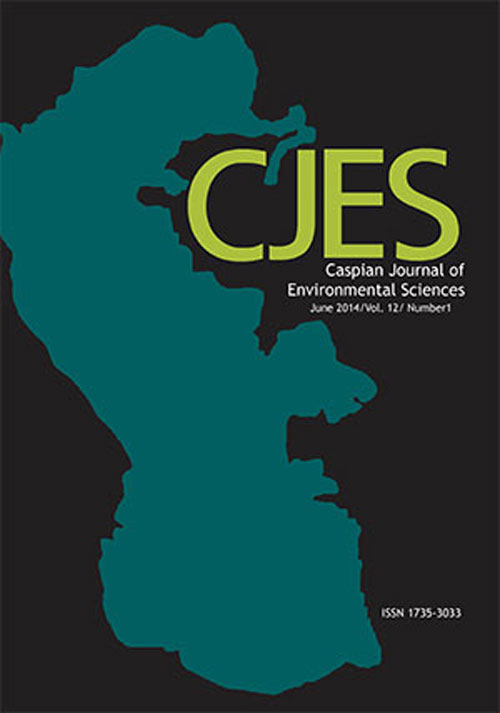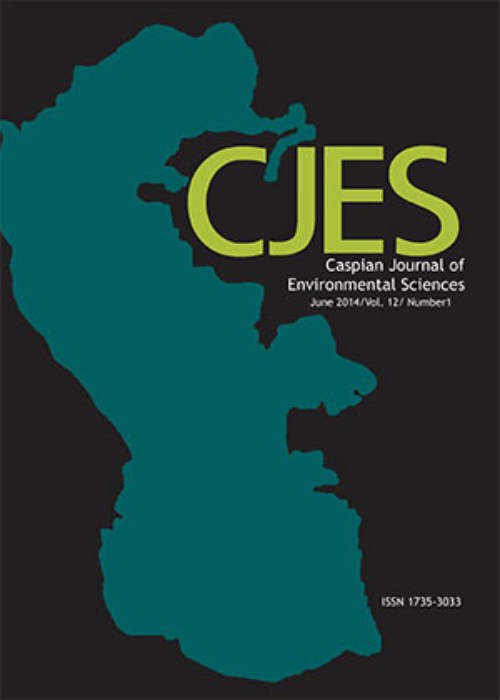فهرست مطالب

Caspian Journal of Environmental Sciences
Volume:14 Issue: 3, Summer 2016
- تاریخ انتشار: 1395/08/02
- تعداد عناوین: 8
-
-
Pages 191-204Despite to its importance for retaining biodiversity and human health, urban wetlands have received much less attention than other wetland types in northern Iran. This study deals with the floristic characteristics of one of the largest urban wetlands in Central Mazandaran, Roshanabad wetland in Babol. All vascular plants were collected during two growing seasons of 2014 and 2015 and water sampling was performed seasonally (autumn 2014 to summer 2015). We encountered 102 plant species belonging to 80 genera and 39 families. The largest families in the studied area were Poaceae with (11.7%) followed by Cyperaceae and Asteraceae (9.8%) and Fabaceae and Polygonaceae (5.9%). Genera represented by the greatest number of species were Cyperus (7 sp.), Polygonum (4 sp.), Ranunculus (3 sp.) and Typha (3 sp.). Classification based on life form, indicated that the therophytes (47%) comprised the largest proportion of the plants in the studied area. From chorological point of view, the largest proportion of the flora belonged to the pluriregional elements (62.3%). Various habitats of the wetland are discussed. Moreover, 63 genera of fresh water algae, belonging to eight phyla were identified in the study area. Cholorophyta with 28 genera was the most abundant phylum followed by Bacillariophyta (19 genera), Cyanophyta (6 genera), Euglenophyta (4 genera), Chrysophyta, Dinophyta (2 genera), and Charophyta, Xanthophyta (each with one genus). Moreover, a comparison between the data as well as ratios of species/genera and genera/families collected from this wetland and from the other wetlands in north Iran has been provided. Roshanabad wetland had fewer aquatic species compared to some other wetlands in north of Iran, because of anthropogenic effects such as penetration of agricultural and urban sewage which has large quantities of nitrate and phosphate, and distribution of exotic aquatic plant, Azolla filiculoides. Moreover, Palmer Index of pollution shows that the wetland has high ratio of pollution in all seasons. This urban wetland site may be considered as a pilot site for the interaction of human effects and biodiversity pool. This is among the first attempts for restoration of such an important and sensitive ecosystem in north of Iran.Keywords: Urban wetland, Macrophytes, Microphytes, Life form, Chorology, Invasive plants
-
Pages 205-213Sulfur dioxide has two important sources in the atmosphere and this is why most of scientists believe in a geographic split in the globe. Power plants, major emitter of SO2, are located in north hemisphere such as in Russia, China, Canada and the USA. In south hemisphere, phytoplankton produces a massive amount of dimethyl sulfide (DMS) and dimethyl disulfide (DMDS). Then these types of reduced products dissociate in the atmosphere and convert into SO2. It is a colorless gas which is released from burning coal, high sulfur coal and diesel fuel. The sulfur dioxide emissions from transportation systems, steel, oil and other industries are major concerns of air pollution in Ahvaz city, Iran. The main objective of this study was to determine the behavior of data over the time in a specific statistical model framework and compare through intended one to implement the Box-Jenkins method to make time series models in Ahvaz (located in Southwestern Iran), during 2013. Data of sulfur dioxide from four monitoring stations were collected at the first step and processed by Excel software; finally, the model of sulfur dioxide dispersion were evaluated. Time series analysis showed that air pollutants were associated with one step delay of sulfur dioxide and two steps delay of moving average. The finding of this study showed that the average concentration of sulfur dioxide in winter was higher than in summer. According to the results of this study, distribution of sulfur dioxide data has a correlated structure over the time; therefore the time series model is an appropriate model to explain the behavior of sulfur dioxide over the time.Keywords: Sulfur dioxide, Emissions, Time series analysis, Iran
-
Pages 215-226Lead (Pb) is one of the most hazardous heavy metal that caused serious problems for ecosystem at recent years. In this study, the effect of Pb on seed germination, incipient growth and antioxidant enzymes of six common used turfgrasses was investigated. The results showed that after implementation of different concentrations (0, 1000, 2000 and 3000 µM) of Pb, Agropyron elongatum exhibited the highest germination percentage (90%) under 3000 µM Pb, followed by Lollium perenne L. (85.56%). The lowest germination parameters including germination vigor, rate, index and germination percentage was found in Festuca ovina, which means it is the most sensitive species to Pb than the other studied turfgrasses. In contrast, F. rubra, F. ovina, A. elongatum and L. perenne had the most significant aerial growth and the lowest chlorophyll degradation even at high lead concentration. An increase in L. perenne and A. elongatum antioxidant enzymes activities as well as a decrease in F. ovina observed after exposure to 3000 µM Pb which correlated to their tolerance and sensitivity to Pb respectively. However, such increase in antioxidant activity was also found in F. Rubra and Poa pratensis but could not inhibit chlorophyll degradation and seedling growth retardation. It might support that there is suggesting the probable existence of a lead-injury mechanism rather than the oxidative stress. Overall, A. elongatum is introduced as the most tolerant turfgrass among studied ones, which could be cultivated in Pb-polluted sites.Keywords: Agropyron, Antioxidant enzymes, Festuca, Lead pollution, Lollium, Poa
-
Pages 227-238Nowadays biodiesel is receiving more attention as a most important renewable energy for using in diesel engines. Inthis research, the application of Response Surface Methodology (RSM) was highlighted to investigate the effects of biodiesel-diesel blends (B0, B20, B50 and B100), engine operating parameters (engine load and speed) on CO2 emission of a diesel engine. The experiments were conducted on a four cylinder direct-injection diesel engine based on three-factor five-level central composite rotatable design. The developed mathematical models were helpful to predict the response parameters and further to identify the significant interactions between the input factors and the responses. The use of biodiesel resulted in higher emission of CO2. The results also showed that an increase in engine speed leads to an increase in the emission of CO2.On the other hand,CO2 emission is higher at low engine loads,while is lower at high engine loads.Keywords: Biodiesel, CO2 Emission, RSM, Diesel Engine
-
Pages 239-251Wild almond (Amygdalus scoparia) is one of the most important species that provides a variety of ecological functions in the Zagros forest ecosystem. In this study, we investigated the effects of some seed treatments on the survival and growth of Amygdalus scoparia after seed planting at different aspects and elevations under natural conditions. The seed pretreatments consisted in soaking them in water at cold (10 °C) and warm (80 °C) temperatures for 24 hours. The impact of these pretreatments was evaluated on the survival rate (%), height and diameter growth of newly emerged seedlings. Based on Duncans test, the height of seedlings established on the north-facing aspect was significantly higher than the other aspects, while the lowest seedling height was observed in the south-facing aspect. The height of seedlings established on east- and west-facing aspects had intermediate values and were statistically similar. The tallest seedlings were observed when seeds were buried at a depth of 2 cm and seedling height tended to decrease with increasing burial depth. Seedlings established on the north-facing aspect at both elevation levels (1200 and 1800 m) were significantly taller than those found on the south-facing aspect. Overall, the use of cold water as a seed pre-treatment in conjunction with a north-facing seedling at a burial depth of 2 cm maximize the survival and the development of Amygdalus scoparia seedlings.Keywords: Wild almond, Afforestation, Seed, Burial depth, Soaking, Physiographic conditions, Zagros
-
Pages 253-261Phytoremediation of heavy metals is employed as a technological approach for a non-destructive remediation of contaminated soils. One of the most recently studied tree species used in phytoremediation applications are poplars. In this study, the one-year old rooted seedlings of Populus nigra L. used to decontaminate hexavalent chromium-contaminated soils. Five treatments of Cr (VI) supply (were spiked as potassium dichromate) including 0 (control, no external Cr = T0), 50 (T50), 100 (T100), 125 (T125) and 150 mg.kg-1 (T150) were employed. It was found that this species not only can reduce large amounts of Cr (VI) in the soil, but also can uptake and accumulate this element in its organs. Both mentioned mechanisms were found to be dose-dependent. A significant linear regression was observed between the all biomass parameters except root diameter (p ≤ 0.05) as well as Cr accumulation in plant tissues (p ≤ 0.01) and chromium concentration in the soil. These findings suggest that this species is suitable for Cr (VI) biomonitoring programs of Cr environmental contamination.Keywords: Soil, P. nigra L., Hexavalent chromium, Phytoremediation, Biomonitoring, Potassium dichromate
-
Pages 263-272Rivers are important water resources for human life, but sometimes cause irreparable damages. The flood plains are fertile terrains which are endangered by flood. Flood hazard mapping is one of the basic methods in flood fighting. In order to decline flood damages, the simulation of the hydraulic behavior of the rivers during flood occurrence is very important. In this study, areas that are flooded were zoned along Siahrood and Goharrood rivers (Rasht City, northern Iran). The rivers bed and banks terrains of Goharrood and Siahrood were simulated using HEC-GeoRAS extension and digital map (scale: 1000). Pick discharges with different return periods were estimated using stochastic analysis. HEC-RAS software and geographical information system were applied for simulating the hydraulic behavior of the rivers and providing flood zoning map. The GIS was an efficient tool for data-processing and mapping stages. Finally, the flood zones associated with 2, 10, 25, 50, 100 and 200 years return periods were mapped and necessary analysis were conducted during the present research. The results showed that some parts of Rasht City (river bank terrains) are endangered flood hazard.Keywords: Flood hazard, GIS, HEC, RAS, Rasht City
-
Pages 273-279To compare the reproductive performance of the wild and cultured stocks of beluga¡ Huso huso males¡ some spermatological parameters were measured including: sperm motility¡ sperm density¡ spermatocrit and also fertilization rate¡ hatching rate and larval growth and survival rates. The semen samples were sampled from 11 wild spawners and 12 cultured brooders. A half of each semen sample was allocated for spermatological analysis and remaining were used for artificial propagation. In wild beluga¡ sperm motility time was 339.09 23.11 s; spermatozoa motility rate 83.64 2.01%; sperm density 15.22 3.46 ×109 and spermatocrit 5.88 1.36% while in cultured beluga¡ sperm motility time was 199.35 29.02 s; spermatozoa motility rate 74.22 2.4 %; sperm density 8.37 0.24 ×109 and spermatocrit 3.21 0.29 %. The fertilization rate (%)¡ hatching rate (%)¡ larval growth (% g.day1). and survival rate (%) in wild beluga were 61.72 14.16¡ 43.33 11.13¡ 12.28 0.33 and 52.66 7.77¡ while in cultured beluga were 49.98 6.55¡ 31.47 8.49¡ 12.28 0.62 and 57.37 7.89 respectively. The spermatozoa motility (the ratio and duration of motility) were significantly different between wild and cultured brooders (P 0.05).Keywords: Sperm density, Sperm motility, Growth rate, Survival rate, Beluga, Huso huso


